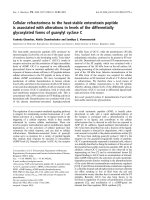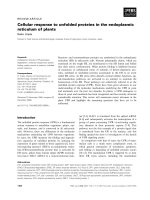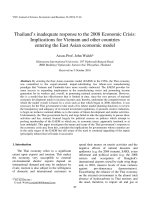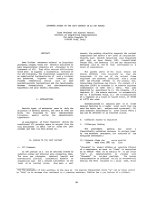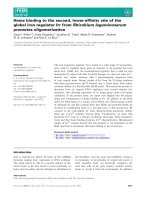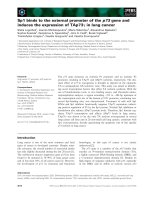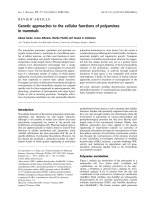Báo cáo " Thailand’s inadequate response to the 2008 Economic Crisis: Implications for Vietnam and other countries entering the East Asian economic model " pptx
Bạn đang xem bản rút gọn của tài liệu. Xem và tải ngay bản đầy đủ của tài liệu tại đây (115.75 KB, 10 trang )
VNU Journal of Science, Economics and Business 26 (2010) 37-46
37
Thailand’s inadequate response to the 2008 Economic Crisis:
Implications for Vietnam and other countries
entering the East Asian economic model
Assoc.Prof. John Walsh*
Shinawatra International University, 197 Viphavadi-Rangsit Road,
BBD Building (Viphavadi), Samsen Nai, Phayathai, Thailand
Received on 5 October 2010
Abstract. By entering the East Asian economic model (EAEM) in the 1950s, the Thai economy
was committed to the export-oriented, import-substituting low labour-cost manufacturing
paradigm that Vietnam and Cambodia have more recently embraced. The EAEM provides for
some success in expanding employment in the manufacturing sector and promoting income
generation for its workers and, overall, in promoting national economic development. However,
this is a model that has effectiveness that is limited in time, since the very process of national
economic development tends to increase incomes and, thereby, undermine the competitiveness on
which the model overall is based. In a crisis such as that which began in 2008, therefore, it was
necessary for the Thai government to take stock of its labour market planning functions, to review
the transparency and adequacy of its inward investment regulations, to promote creative industries,
to begin an inclusive national debate as to the nature of future development and similar activities.
Unfortunately, the Thai government has by and large failed to take the opportunity to pursue these
activities and has, instead, focused largely for political reasons on policies which attempt to
prolong membership of the EAEM or which are, in economic terms, apparently irrational or at
least unhelpful. This paper investigates the nature and scope of the Thai government’s response to
the economic crisis and, from this, considers the implications for governments whose countries are
in the early stages of the EAEM but still aware of the need to continual upgrading of the inputs
(principally labour) that will make it successful.
1. Introduction
*
The Thai economy relies to a significant
extent upon exports and tourism. This makes
the economy very susceptible to external
environmental shocks: exports depend on
international demand and may be undercut by
rivals; tourism is also subject to the willingness
of domestic and international customers to
______
* Tel: 02-650 6011
E-mail: Walsh
spend their money on tourist activities and the
negative effects of natural disasters and
epidemics (e.g. the 2004 tsunami, SARS, avian
influenza) and political action (e.g. the 2008
seizure and occupation of Bangkok’s
international airports seized by right wing thugs
and, in 2010, massive levels of state violence
against pro-democracy demonstrators).
Exacerbating the reliance of the Thai economy
on the external environment is the almost total
absence of hydrocarbons in Thai territory and
the need, therefore, to import oil and gas at
J. Walsh / VNU Journal of Science, Economic and Business 26, No. 5E (2010) 37-46
38
international market prices. As is evident, the
price of oil and gas has been mostly at elevated
levels in recent years and, given the nature of
scarce resources and ever-increasing demand,
those high prices will be likely to continue into
the foreseeable future. In addition, the Thai
economy must also contend with the rise of
new competitors such as China and Vietnam,
able to provide rival goods at competitive
prices. As standards of living have generally
risen in Thailand, the ability of the country to
compete in terms of the low prices of
commodities or commodity-like objects has
eroded. New forms of competitiveness are,
consequently, required. The global economic
crisis initiated by the banking crisis of 2008 has
revealed the stark nature of the need for radical
change in the Thai economy. The very model of
development on which the economy has
depended since the 1950s (which is a variant of
what is termed here the East Asian Economic
Model (EAEM)) is no longer appropriate to
form the basis for future or even current
economic progression. While the Thai Rak Thai
administration of 2001-6 appreciated these
issues and set in motion policies to convert the
economy to work according to different
dynamics, the disastrous military coup of 2006
has been followed by military rule and the
installation of military-approved regime which
has proved to be brutal, corrupt and incompetent.
This has been revealed starkly by the response to
the ongoing economic crisis, which has been
characterised by lack of focus, short-termism,
political rather than economic criteria used for
expenditure and the lack of a coherent vision for
future development of the country.
This paper described the nature of the
EAEM as it has been manifested in the case of
Thailand, as a means of helping to understand
how the economy needs to change in response
to current and probably future changes in the
global economy. It then goes on to describe and
analyse the stimulus package and other measures
taken by the Thai government as a means of
combating the economic crisis and then provides
a critique of that response. This is conducted with
a view to identifying the implications for other
countries which have also embarked upon a
version of the EAEM, notably of course Vietnam.
A conclusion completes the paper.
2. The East Asian economic model
The East Asian Economic Model (EAEM)
is based on import-substituting, export-
promoting manufacturing with competitiveness
based on low labour costs. Labour costs have
been kept low, in general terms, by moving
people from agriculture into industry, accepting
inward flows of legal and illegal migrant
workers and the use of the police and military
to suppress workers’ rights, freedom of
association and freedom of speech. As Studwell
has observed:
“The great discovery of south-east Asian
governments in the late 1960s was that their
diverse populations (contrary to colonial myth)
were rather uniformly hard-working and would
happily toil through the day and night in
factories making clothing, shoes, appliances
and electronics. Government needed only to
woo investment - most of it foreign - with full
ownership rights for production facilities, tax
breaks and central bank intervention to keep
local currencies undervalued and hence exports
cheap. The proposition was irresistible for cost-
cutting multinationals and spawned globally
competitive, but small-scale local businesses to
provide components and contract
manufacturing and support services: anything
from making models for toy moulds to
packaging semiconductors to cleaning
multinationals’ factories” (Studwell, 2007,
p.xxiii).
The Communist or former Communist
members of Southeast Asia, Vietnam, Laos and
Cambodia, have now embraced their own
versions of the EAEM. The kinds of
manufacturing industries involved have
included garments and shoes, processed
agricultural products and seafood, electronic
J. Walsh / VNU Journal of Science, Economic and Business 26, No. 5E (2010) 37-46
39
components, automotive and semi-conductors.
In general terms, the technology for this kind of
manufacturing is quite widely diffused around
the world and the need for skilled workers
limited. Commodity labour prices, in other
words, have remained of the greatest
importance. To support labour markets of this
nature, it has been necessary for states to
maintain educational systems that, for the
working classes at least, promote rote learning,
discipline (i.e. obedience) and the advancement
of ‘traditional cultural norms’ such as deference
to authority figures, willingness to accept
injustice mutely and self-abnegation in the light
of state development goals. The results of the
education system are reinforced by additional
aspects of the East Asian Development Model
(EADM), which include limitations on
democracy, censorship, self-censorship,
promotion of national ideologies and, again, the
need for obedience. The EADM routinely
includes, therefore, a compliant pro-
establishment media, patronage systems,
neutered labour movements and a culture of
antipathy towards politicians who might
represent a genuine threat to the status quo. The
EAEM relates to the economic basis of
development of the country; the EADM
includes the configuration of the political and
cultural aspects that are also used to reinforce
the economic base of development.
All economic activities eventually become
obsolete, of course, usually after having first
passed through a period of decreasing
relevance. This process is accelerated or
intensified by the onset of an economic crisis
such as that which began in 2008. Under
conditions of competition, some firms will fail
and others will flourish and grow in size and
their structures become part of internationalized
(and sometimes globalized) firm-firm networks
and are embedded in international or global
production networks (Chung, 2009). At such a
point, it has been argued, the firms involved
have effectively grown beyond the reach of the
governments that helped to give them birth.
Examples of such firms include Hyundai, LG
and Samsung from Korea. However, the
relationship between the Korean government
and its economic actors was antagonistic for
many years, particularly in the early parts of the
Korean EAEM. Easing of tensions only
occurred with overall growth of the national
economy and the firms themselves found more
resources to enact their future plans. Even so,
the firms have still been enacting to some
extent national development goals, albeit
through incentives rather than obligation
(Moon, 1994). As the leading firms
increasingly recognise that their future growth
lies as much in the Knowledge-Based Economy
(KBE) as it does in manufacturing or services.
The two have worked together to achieve high
value-added production means and processes,
with government providing infrastructure and
highly-qualified labour while the private sector
deals with entrepreneurial aspects, finance,
marketing, distribution and so forth. Although
the nature of the relationship has changed,
therefore, its existence continues along different
lines. This may not be possible in western
countries, for example, where large and
transnational firms have become much more
decoupled from their original home states or
host states (cf. Hutton, 1996).
Clearly, therefore, the nature and indeed
existence of the EAEM is not uncontested.
There has been a tendency to see the nature of
the developmental state as being, in simple
terms, statist in nature: the state determines its
various goals which it can force private sector
agents to transact. In fact, as suggested above,
the relationship between public and private
sector in the developmental states of East Asia
has neither been stable nor unproblematic.
Thailand has broadly followed in the footsteps
of Korea in that, lacking resources, the state has
entrusted the private sector to carry out state
developmental goals on behalf of the state
which, in return, smoothes the way for firms to
complete their own goals. There are other forms
of relationship: in Taiwan, for example,
J. Walsh / VNU Journal of Science, Economic and Business 26, No. 5E (2010) 37-46
40
developmental goals were entrusted to
government-linked companies (GLCs) which,
as their names suggest, are partly-owned and
administered by the state and which can be
expected to do what is required (Chu, 1994).
The situation in mainland China at the
beginning of the C21st has some similarities
with the Taiwanese example in that State
Owned Enterprises (SOEs), in some cases
corporatized or under some other organizational
structure and ownership, are busily conducting
economic activities which are congruent with
national goals, particularly with respect to
constructing infrastructure in the Mekong
region. There are, in other words, significant
variations within the different EAEMs and
EADMs (e.g. Park, 2002). In some ways this
reflects the different configurations of the
superstructures of politics, culture and societal
arrangements that sit atop the economic bases
of the countries involved.
The spatial location of industrial
development and related residential
accommodation has also been significantly
influenced by the EAEM. Commonly, certain
areas of land are designated as being industrial
estates, export processing zones, special
economic zones or some similar terminology
and these areas are provided with often
subsidized public services such as electricity,
water and transportation, while government-
provided incentives are provided to encourage
domestic and, especially, international investors
to locate their economic activities there.
Generally, these areas will be located with a
view to low labour cost manufacturing rather
than resource extraction activities.
Consequently, there is a need to attract people
to the area to take the jobs provided under the
conditions available. In some cases, the local
communities and provincial population centres
will provide a sufficient labour force to meet
demand but it is more likely that over-supply of
labour will lead to a suppression of wages and
the hiring of people from more remote regions
where lower standards of living are normal. In
some cases, ethnic minority people or
international labour migrants are used to
depress wages further and to undermine such
labour rights as do exist. While this approach
can provide some dynamic economic growth, it
is also common for factories to be established
aimed at conducting commercial or
manufacturing activities which are only
possible because of the conditions applying in
the special zones in which they are located.
In any case, the concentration of workers
means there is a need for accommodation,
perhaps dormitories which can be more easily
monitored, and the issues of social control that
arise under such circumstances. Much factory
work is considered to be gender-specific and,
so, the accommodation must provide for a
preponderance of either male or female
workers. It is well-known that social issues may
easily arise in these kinds of circumstances,
while there may also be problems caused by
sub-contractor companies and brokers. If
transportation infrastructure improves,
alongside personal living standards and hence
the access to personal forms of transport, then
the labour force may become more dispersed
and seek to live in the more exciting urban
communities. As is evident from similar
situations around the world, the entrance of
comparatively large numbers of newcomers
into a settled community can be the cause of
tension and possible conflict. This issue may be
exacerbated when ethnic, regional or class
issues are involved. Sensitive provision of
public services and administration are required
to handle the situation. As Kundu (2009) has
observed, Thailand has in common with many
Asian countries undergone processes by which
the numbers of migrant including international
migrant workers has increased considerably
over recent decades and certain large urban
centres are beginning to feel the strain of
growth in terms of public service provision,
pollution, crowding and o forth are concerned.
From a positive perspective, it is possible for a
country entering the EAEM or at an early stage
J. Walsh / VNU Journal of Science, Economic and Business 26, No. 5E (2010) 37-46
41
of its working to seek to manage the spatial
location of such industrial zones and to take
action to ensure smooth provision of services
and related matters.
In terms of social issues, there is one
specific consideration relating to changing
gender relations. When groups of women are
drawn to a remote area to work together in a
factory setting and perhaps dormitory
accommodation, they can in some cases be
empowered to take a greater level of control
over their own lives and personal relationships
and this might prove to be problematic if they
then return to home areas where less
enlightened attitudes persist.
Finally, it is necessary to consider the issue
of demographic change. Thailand has a
population that is gradually ageing and the
number of children being born per adult woman
has been declining in conformity with well-
known economic conventions. These changes
are inimical to the smooth running of the
EAEM, which requires a constant stream of
new entrants into the labour market willing to
work for low wages and to move across the
country in response to new work opportunities.
Since Thailand has a well-established seniority
system in terms of terms and conditions, older
workers tend to expect to be paid more purely
as a result of their seniority and the
presumption of greater experience and skill. As
workers have tended to become older and, also,
better paid, therefore, the ability of the country
to maintain its current expression of the EAEM
has declined to the same extent.
The EAEM can be a powerful tool for
economic change in a mostly poor country or in
a country with a dual economy, one part of
which has comparatively large numbers of poor
people. However, it is not a tool that can be
wielded without consideration for the
externalities attendant upon it: instead, attention
should be paid to the EAEM’s impact upon
geographic location of economic activities, its
dynamic nature in changing the lives of those
involved with it and its impact on social and
gender relations, among other area. Above all,
the EAEM is a dynamic and transitory force,
which cannot be preserved indefinitely and nor
should it be. A subsequent section of this paper
seeks to identify the implications of these issues
for a country such as Vietnam, which has only
recently entered the EAEM.
3. The Response to the Crisis: Thai Khem
Khaeng
The Thai government took action to provide
economic stimulus, in line with the zeitgeist,
not wishing to be thought of as being out of
step with international sentiment. The stimulus
package was launched under the slogan Thai
Khem Khang (‘Stronger Thailand’). It
consisted, initially, of a proposed and
subsequently implemented budget that provided
for funds in specific areas. These included plans
to extend free public sector education places,
create as many as 10,000 new hospital beds in
the public sector and develop a number of small
and medium size infrastructure projects
between 2010-2 (on the basis that large-scale
infrastructure projects are being financed at
least in part by the Asian Development Bank
and other international partners). The first
package, known as SP1, was aimed primarily at
alleviating the misery of the poor through short-
term tax breaks, subsidies for public utilities
and services for low income households, as
well as one-time cash handouts for low-income
workers (Chantanusornsiri, 2009). The second
part of the package has become known as SP2
or Thai Khem Khaeng and involves committing
some 1.43 trillion baht for numerous loosely-
defined infrastructure projects across the range
of the country and its various industries
(progress in these projects is detailed in the
table below).
J. Walsh / VNU Journal of Science, Economic and Business 26, No. 5E (2010) 37-46
42
Table 1: Progress of Projects under SP2 (Thai Khem Khaeng)
Number of projects Value (million baht) % Age
Approved 42,258 349,960.44 100
Allotment 38,922 320,760.88 91.6
Signed contract 35,985 292,028.20 83.4
Disbursed 34,231 234,400.87 66.9
Completed 1,940 33,078.79 9.4
Source: Government Website, />To meet these promises, if indeed they are
to be met, the government plans to run deficit
budgets for the next few years as public debt is
anticipated to increase from 40% of GDP at the
end of 2009 to as high as 60% of GDP at its
highest point. However, it is clear that
government projections for the recovery of
economic growth depend on the return of
export markets to their previous levels. It is by
no means certain that these markets will swiftly
or persistently return to pre-crisis levels,
though, since many European nations have
ignored the lessons provided by Keynes of
avoiding economic recessions by expanding the
public sector to become the principal engine of
growth until such time as the private sector is
able to resume this role. Instead, these states are
precipitately rushing to reduce their deficits and
hope, without much evidence to justify such a
hope, that they will be able to export their way
back into positive growth. This has an impact
around the world, of course, since international
trade links many states to many: in a globalized
world, decline in imports in one country or
region tends to spread around the world and,
when recession has already weakened
international confidence internationally, the
system remains fragile.
To understand the nature of the Thai
response to the crisis, it is helpful to consider
the component of the creative industries, which
is indicative of the nature of the two stimulus
packages (see table below).
Table 2: Creative Economy Funding, 2010-2 (figures in millions of baht)
Ministry/Agency Projects 2010
Budget
2011
Budget
2012
Budget
Total
ICT Ministry 1 200.0 0 0 200.0
Natural Resources and Environment 3 301.0 175.0 174.0 650.0
PM’s Office 6 2,654.5 2,805.3 2,805.3 8,265.0
Industry Ministry 22 1,452.7 3,655.4 2,265.1 7,373.1
Public Health Ministry 2 10.0 7.0 7.0 24.0
Science and Technology Ministry 8 930.0 1,031.0 1,021.0 2,982.0
Culture Ministry 3 250.0 77.0 313.0 640.0
Total 45 5,798.2 7,750.6 6,585.4 20,134.1
Source: Government Website,
First of all, it is notable that a large
proportion of the budget concerned has been
allocated to the Prime Minister’s Office, which
makes scrutiny of disbursement and selection
particularly difficult. Second, the funding was
not put into place until 2010 at the earliest,
despite the realization in 2008 that urgent action
was required. Third, the composition of the
funding leaves some decisions open to question.
This is in part because of the perceived
dimension of allocating projects to different
areas depending on the control of ministries
within the ruling coalition. Hence, only three
projects were awarded to the Culture Ministry
while 22 were allotted to the Industry Ministry.
A government spokesperson claimed that some
J. Walsh / VNU Journal of Science, Economic and Business 26, No. 5E (2010) 37-46
43
proposals had been rejected because they had
simply added the word ‘creative’ to the
proposal forms and provided examples of the
successful projects funded under the Prime
Minister’s Office, under the Office of
Knowledge Management and Development
(who provided the abovementinoed
spokesperson): “… the Creative City; the
OKMD Creative Awards; the executive creative
economic training programme; the Creative
Mobile, which provides knowledge and training
for people upcountry through roadshows; and
website development to publicise information.
The Creative City initiative, running from
November 2009 to March 2010, includes
Creative Shops in Bangkok, a Creative Music
Festival where a variety of concerts, some
featuring “underground” artists will be staged,
and Creative Studio, which provides space for
anyone wishing to showcase their
achievements. The Bangkok Food Festival
would also be held to promote the capital as not
only a city of fun but also a city of food
diversity (Theparat, 2009).” It is clear from this
that the creative industries are defined as
including international interests and without
any specific element of ‘Thainess’ - although
this concept has been used in other aspects of
contemporary government policy
(Apivantanaporn and Walsh, 2010). It is also
clear that this approach appears dominated not
just by urban-centred policies but by a vision of
consumerist globalisation that is generally
rejected in ideological terms by the Abhisit
regime and its supporters. Indeed, these policies
might well have derived from the previous, much
derided Thai Rak Thai administration. This form
of capitalism is in many ways a logical response
to the crisis of capitalism with which Thailand as
part of the modern world has been faced but
admitting it would be more honest.
4. Critique of the Thai response
As the World Bank has indicated, economic
recovery in Thailand has depended almost
entirely on the recovery of exporting as
international export markets have (perhaps only
temporarily) returned to their previous levels
prior to the crisis (World Bank, 2010). This is
problematic and renders much of the rest of the
programe vulnerable to the charge that it is
either just window-dressing or the reassignment
of existing (or aspirational) policies under a
different name for the government’s marketing
purposes.
The Thai Khem Kaeng campaign has been
mixed in terms of success. While the use of an
economic stimulus package was clearly correct
in the prevailing conditions, the way in which it
has been structured and administered has been
problematic. The principal areas of concern are:
• Lack of transparency in terms of
prioritizing specific projects. It is widely
thought that party political considerations have
been influential in determining which of the
competing projects receive funding. This has
been because of the perceived need for the
Democrat party to reward its coalition members
with revenue-making opportunities;
• The tardiness with which funds have
actually been disbursed. It has become
something of a tradition for right-wing Thai
governments to try to conserve parts of its
budget, perhaps to allow for contingencies or to
permit some kind of discretionary spending;
• The focus of much of the spending: while
there was clearly a need for some relief
assistance to the poor, too many projects aimed
to be purely redistributive in nature without any
meaningful anticipation of leading to economic
growth overall;
• The lack of an overall vision for the future
direction of the economy. What vision has been
revealed seems to be based on the idea that
short-term survival will be sufficient until such
time as the rest of the world is ready to begin
importing once again. At the time of writing, it
appears that the excessive deficit-cutting in
Europe is putting the economic revival sparked
by the early Brown-Obama leadership is in
danger of being squandered;
• The lack of co-ordination between
different aspects of economic policy, leading to
J. Walsh / VNU Journal of Science, Economic and Business 26, No. 5E (2010) 37-46
44
the under-development (or even contradiction
between) the different elements of government
action. Free education is to be extended, for
example, for students of government sector
schools yet there is no mechanism that links
demand for labour with its supply. Indeed,
many government agencies not only compete
with each other for scarce resources but even
replicate each other’s activities.
In addition to these issues, what is perhaps
just as important is the way in which party
political interests have contradicted stated
economic goals. For example, competitiveness
in exporting has been significantly undermined
by the continual rise of the value of the baht
resulting from continued inward flows of
capital, the desire for entry into the KBE has
been ruined by the incredibly severe restriction
of free speech and civil liberties by the Abhisit
regime (which has banned more than one
hundred thousand websites, closed dozens of
community radio stations, arrested numerous
people for the supposed crime of lese majeste
and held the threat of emergency rule over
much of the country), while the resurrection of
the EAEM by inviting more inwards investment
has been hampered by the incompetent handling
of the pollution caused by certain installations
in the Map Tha Put Industrial Estate.
Irrespective of any virtues attached to the Thai
Khem Khaeng programme, its values and
purposes have been almost totally obscured by
contradictory and often short-term, party-
political policies and initiative announced by
members of the Abhisit regime. This has
seriously and needlessly undermined the
possible recovery of the Thai economy, which
has of course fallen most harshly on the poor
and the vulnerable.
5. The Vietnamese context
Thailand has reached what the World Bank
has called the Middle Income Trap: that is, the
country developed a means to raise itself from
low income status to middle income status (that
is, the EAEM), yet that method is insufficient
for it to be transformed from middle income to
high income status (Gill and Kharas, 2007: 17-
8). A qualitative change is needed in economic
structure and purpose in order to escape from
the middle income trap. The leading example
for East and Southeast Asian nations to follow
is that of the Republic of Korea (South Korea or
ROK). This country was once one of the very
poorest in the world but has, in unprecedented
fashion, moved from being a recipient of aid to
an aid donor and a member of the Organisation
of Economic cooperation and Development
(OECD), which is often causally referred to as
the “rich countries’ club.” Korea achieved this
initially through a fierce application of the
EAEM, which was followed until its logical
conclusion and the recognition of the need to
change, which may be said to coincide with the
awarding of the Seoul Olympics that were
finally held in 1988. The government led the
debate (and took a leading role in planning and
implementing subsequent policies) that resulted
in greater democratization, leading to freer
speech and the unleashing of the creativity of
Korean citizens. This has been accompanied by
a comprehensive development of internet
infrastructure that has made the country the
most wired in the world, according to many
estimates. The government has also been
prominent in labour market planning, in which
steps have been taken to identify future demand
for labour together with ensuring that the
supply of appropriately skilled and rewarded
individuals will help to meet that demand.
However, of great importance has been the
recognition that the public sector is unable to
make this qualitative change on its own but has
required the entrepreneurial ability and focused
creativity of the private sector in order to
empower all aspects of society in contributing
to economic growth. Growth has, as a result,
been extremely successful, even if some issues
of sustainability, the limits of constant
economic growth and environmental
degradation have not yet been fully addressed.
J. Walsh / VNU Journal of Science, Economic and Business 26, No. 5E (2010) 37-46
45
What can Vietnam learn from this? First
there is the need for coordination between
demand and (future) supply in the labour
market - the jobs that will be available in the
future are not by any means those which are
likely to be available today and, hence, there is
a need for flexibility in the way in which young
people are taught (promoting learning and
preferably lifelong skills) and the content of
what they are taught (including computer skills,
creativity, entrepreneurial attitudes and the like)
in addition to the political, social and cultural
aspects of learning that are deemed to be
appropriate for Vietnamese citizens. Secondly,
there is a need to understand the degree to
which the EAEM is a temporary phenomenon
and should be managed for change in the
context of emergent although as yet invisible
competitors. Thirdly, an integrated vision of the
future economy and the areas in which
competitive advantage can be sustained is of
great importance but will not be available
without considerable thought and development.
In some senses, free speech and
democratization of the people in economic and
political terms may be helpful in this context.
The 1997 Asian Financial Crisis, which is
often referred to in Thailand as the ‘tom yum
kung’ crisis, as if it had some special Thai
characteristic attached to it, brought the IMF
and its conditionalities to Thailand and
encouraged policy-makers and financial elites
to begin to speak with the discourse of
prudence and parsimony and gave a means of
justification for those who believed in policies
known as fiscal rectitude. The crisis also had
the more positive aspect of requiring certain
banks to address the issues of non-performing
loans and assets and forcing the revaluation of
some assets which had undergone bubble
inflation. The pain that this caused in Thailand,
as in many other countries, was of course
significant and, as ever, it was the vulnerable
who suffered the most, not least because of the
mostly inappropriate conditions inflicted by the
IMF on the Thai economy. Subsequently, the
desire to repay the money borrowed to see out
the problems of the crisis became seen as a
patriotic national goal and was accorded to be a
notable coup, when it was achieved, by the Thai
Tak Thai administration of 2001-6. However, it
also provided not just a discourse but also a
pretext for the elitists who wield extra-judicial
power in the Kingdom with a means of
discrediting redistributive politics as being
‘populist’ and, intrinsically, inefficient and even
immoral. This has been used, as it has by the
Conservative party in the UK, the Republicans
in the USA and the right wing across
continental Europe for an excuse for regressive
taxation and social security politics. Curiously,
however, the current Abhisit regime has
wedded this censorious tone with open
populism in the form of vote-buying by making
obviously unsustainable promises to the people
(most recently by suggesting an immediate 25-
30% rise in the minimum wage in Bangkok)
with, apparently, a view to gaining political
support.
A number of different states have attempted
to reconcile the causes changed by the EAEM
and the desire to maintain its continuance and
the continuance of the benefits that it brings. An
understanding of these issues is the first step
towards appreciating the steps needed to be
taken when one of the periodical crises of
capitalism next arrives.
References
[1] Apivantanaporn, Thanan and John Walsh,
“Innovative Drivers for New Business Creation,”
Paper presented at the ICBER (Kuala Lumpur,
November 2010).
[2] Chantanusornsiri, Wichit, “From Strength to
Strength,” Bangkok Post 2009 Year-End Economic
Review (Bangkok: December, 2009), p12.
[3] Chu, Yun-Han (1994), “The Realignment of
Business-Government Relations and Regime
Transition in Taiwan,” in MacIntyre, Andrew, ed.,
Business and Government in Industrialising Asia
(Ithaca, New York: Cornell University Press),
pp.113-41.
J. Walsh / VNU Journal of Science, Economic and Business 26, No. 5E (2010) 37-46
46
[4] Chung, Henry Wai-Chung, “Drivers of
Globalization: An Evolutionary Perspective on
Firm-State Relations in the Asian Newly
Industrialized Economies,” Papers in Evolutionary
Economic Geography, #9.20 (University of
Utrecht), available at:
[5] Gill, Indermit and Homi Kharas, An East Asian
Renaissance: Ideas for Economic Growth (World
Bank, 2007).
[6] Hutton, Will (1996), The State We’re In, revised
edition (London: Vintage).
[7] Kundu, Amitabh, “Urbanisation and Migration: An
Analysis of Trends, Patterns and Policies in Asia,”
Human Development Research Paper, 2009/16
(December) (United Nations Development Project),
available at: -
muenchen.de/19197/.
[8] Moon, Chung-In (1994), “Changing Patterns of
Business-Government Relations in South Korea,” in
MacIntyre, ed., op.cit., pp.142-66.
[9] Park, Jong H., “The East Asian Model of Economic
Development and Developing Countries,” Journal
of Developing Societies, Vol.18, No.4 (2002),
pp.330-53.
[10] Studwell, Joe, Asian Godfathers: Money and Power
in Hong Kong and South-East Asia (London:
Profile Books, 2007).
[11] Theparat, Chatrudee, “Firms Seeking State Funds
Must Match Words with Deeds,” Bangkok Post
Year-End Economic Review (Bangkok: December,
2009), p.27.
[12] World Bank, “Thai Economic Recovery Still
Driven by Export Growth, World Bank Says” (June
24th, 2010), available at:
Phản ứng kém hiệu quả của Thái Lan
với cuộc khủng hoảng kinh tế 2008: Bài học cho Việt Nam và
các nước tham gia mô hình kinh tế Đông Á
PGS. John Walsh
Trường Đại học Quốc tế Shinawatra, 197 đường Viphavadi-Rangsit,
Tòa nhà BBD, Samsen Nai, Phayathai, Thái Lan
Tóm tắt: Khi tham gia vào Mô hình kinh tế Đông Á (EAEM) từ những năm 1950, Thái Lan cam
kết theo đuổi mô hình sản xuất giá thành lao động rẻ, định hướng xuất khẩu thay cho nhập khẩu mà
gần đây Việt Nam và Campuchia đang thực hiện. Mô hình EAEM đã tạo ra được nhiều cơ hội việc
làm trong lĩnh vực sản xuất, tăng tạo thu nhập cho người lao động đồng thời đẩy mạnh nền kinh tế
quốc dân. Tuy nhiên, mô hình này cũng còn hạn chế vì quá phát triển của kinh tế quốc dân mặc dù
nâng cao thu nhập song lại khiến năng lực cạnh trạnh của mô hình bị suy giảm. Do vậy, với một cuộc
khủng hoảng như đã xảy ra vào năm 2008, chính phủ Thái Lan đáng lẽ đã phải thực hiện các chức
năng như qui hoạch thị trường lao động, đánh giá mức độ rõ ràng và toàn diện của các qui định về đầu
tư trong nước, kích thích các ngành sáng tạo, bắt đầu thảo luận trên cả nước về bản chất của các hoạt
động phát triển trong tương lai và tương đương. Song thật đáng tiếc, chính phủ Thái Lan đã không tận
dụng cơ hội để theo đuổi những nội dung này, ngược lại họ đã tập trung vào các yếu tố chính trị liên
quan tới chính sách nhằm kéo dài vai trò thành viên EAEM hoặc nói theo cách khác là họ đã trở nên
vô ích. Bài viết đã phân tích bản chất và phạm vi của những phản hồi từ phía chính phủ Thái Lan đối
với cuộc khủng hoảng, từ đó, xem xét ý nghĩa đối với các chính phủ đang bước vào giai đoạn đầu của
EAEM song đã nhận thức được nhu cầu cần liên tục nâng cao lực lượng lao động để đảm bảo sự phát
triển bền vững của nền kinh tế.
